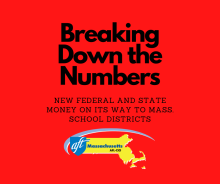Significant federal and state aid for schools may have already arrived in your school district—and more may be on the way, from both federal and state sources. This story, current as of early February 2021, provides a breakdown of what has already happened—and what to expect in the coming months.

First Round of Federal Support for K-12 Education: ESSER I and COVID Relief Fund
Following the outbreak of the coronavirus pandemic in early 2020, the U.S. Congress enacted a sweeping $2.2. trillion relief bill in March 2020 called the CARES Act—The Coronavirus Aid, Relief, and Economic Security Act.
The CARES Act included substantial support for preK-12 education, higher education, and states, cities, and towns. The two most significant sources of K-12 financial support were the following programs:
- Elementary and Secondary Schools Emergency Relief (ESSER) Fund: $215 million to MA districts, distributed to districts via the Title I formula.
- Coronavirus Relief Fund (CvRF): $202 million to MA districts, distributed on a per-pupil basis (a flat $225 per pupil).
To see your district’s share of ESSER funds from this first round of relief (referred to as “ESSER I”), visit this web page hosted by the Department of Elementary and Secondary Education (DESE).
It is possible that most of the money from this first round of federal relief—ESSER I and CvRF—has already been spent, but you should ask your district if any money is remaining and how much.
Second Round of Federal Support for K-12 Education: ESSER II
Recognizing the intensifying needs of U.S. residents, students, and businesses as a result of the pandemic, the U.S. Congress passed a second coronavirus relief bill in December 2020: the $900 billion Coronavirus Response and Relief Supplemental Appropriations Act. This bill extended and expanded the original ESSER program, nearly quadrupling the amount of federal ESSER aid to $54 billion nationally.
Of that $54 billion, approximately $815 million will go to school districts in Massachusetts. To find a breakdown of projected ESSER II allocations to MA districts, visit this DESE page and click on the Excel spreadsheet entitled “ESSER II Allocations.”
It’s important to note that the allowable uses for ESSER II funds are quite broad and flexible, encompassing any activity authorized by the Every Student Succeeds Act (ESSA) and several other federal education laws.
There are additional allowable uses as well, including school facility repairs and improvements, such as efforts to improve indoor air quality. For a complete list of allowable uses, visit this DESE page and click on “ESSER II Quick Reference Guide.”
The ESSER II grant application, to be completed by school districts, is now available from DESE. ESSER II funds must be spent before September 30, 2023.
The FY 22 State Budget, Governor Baker’s Budget Proposal, and Projected Chapter 70 Aid
The winter normally kicks off state budget season—a period of negotiations among the governor and the two legislative chambers that normally extends into early summer and sometimes beyond. January 2021 was no exception to this rule. On Jan. 27, Governor Baker released his FY 22 state budget proposal, the details of which can be found in a press release from the governor’s office.
The governor’s budget proposal includes $246.3 million in new K-12 funding, including:
- An increase of $197.7 million in Chapter 70 funding
- An increase of $26.1 million in charter school reimbursement monies
- An increase of $22.5 million for special education circuit breaker reimbursement
Governor Baker claims to fully fund the first year of the Student Opportunity Act (SOA) in his budget, but school-funding advocates, including AFT Massachusetts and the Massachusetts Education Justice Alliance, have raised concerns about whether the budget goes far enough to fulfill the promise of SOA.
While the final state budget could look different once it goes through the Legislature, district-by-district projections of Chapter 70 aid and charter reimbursement monies based on the governor’s budget are currently available to serve as a guide to districts.
The so-called “cherry sheet” estimates from the Mass. Dept. of Revenue are normally the first place to look for projections. Go here for the cherry sheets for municipalities and here for the cherry sheets for regional schools, including regional vocational-technical schools.
If you want to dig deeper into the numbers, detailed Chapter 70 breakdowns for districts showing net school spending requirements, Chapter 70 aid amounts, and required district contributions are produced by DESE and can be found at this DESE webpage. Scroll to the bottom of the page and then click on the Excel spreadsheet entitled “Complete formula spreadsheet,” which shows the detailed calculations for each municipality and district.
What Else Should We Keep an Eye On?
As budget season moves forward, there are two key variables to keep a close eye on: what happens in Washington, D.C.; and what happens at the Massachusetts State House.
At the federal level, President Joe Biden is pushing for a third COVID relief package to the tune of $1.9 trillion. Preliminary reports suggest that any final package may contain additional aid for states, cities, and towns, and for schools. The national AFT will be watching developments closely, so stay tuned for more.
At the state level, all eyes will be on the Legislature as Gov. Baker’s budget proposal winds its way through the various budget committees in each chamber, culminating in a final vote around the start of summer (most likely). School-funding advocates will be seeking an accelerated timeline for the phase-in of the Student Opportunity Act, among other improvements to Baker’s budget proposal.
Putting It All Together: An AFT MA PowerPoint
For a one-stop-shopping overview of the federal and state school finance picture, check out this presentation prepared by AFT Massachusetts. Any additional questions may be directed to AFT MA staff.
